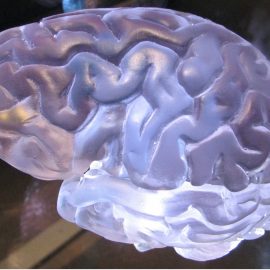

This article is an excerpt from the Shortform book guide to "Stumbling on Happiness" by Daniel Gilbert. Shortform has the world's best summaries and analyses of books you should be reading.
Like this article? Sign up for a free trial here .
Are you perceiving reality accurately, or do you have blind spots in your perception? Does everybody perceive the world in the same way?
According to Harvard professor and social psychologist Daniel Gilbert, we all are perceiving reality through a distorted lens. Gilbert says that your brain fabricates your present reality by filling in visual and aural gaps in your perception with assumed information—and by interpreting present events in a way that’s advantageous to you.
Here are the two fabrications that most people make about reality.
Fabrication #1: Your Brain Fills in Gaps in the Present With Assumed Information
The first problem with perceiving reality is that your brain doesn’t just fill in the gaps in your memory with assumed information. It even fills in the gaps in your visual and aural perception of the world right now with assumed information.
First, says Gilbert, you have a literal blind spot—a small area you can’t see—and your brain fills in that spot based on what it sees around it. For example, if you’re looking at a blue sky, but part of your perception is obscured by your blind spot, your brain will fill in the blind spot with the blue sky it does see.
Second, adds Gilbert, your brain fills in sounds you don’t hear clearly or fully with approximations based on the contextual sounds you do hear. For example, if you’re talking to a friend while a dog barks nearby, you might technically only hear: “Today was a long day, so I’ll go to -eep early tonight.” However, your mind will fill in the missing sound “sl” to create the word “sleep” because that makes the most sense given the context of the sentence.
| Your Brain Prefers Fabricated Information Gilbert contends that your brain supplements your visual and aural perception of reality with fabricated information. He doesn’t mention that your brain may trust that fabricated information more than the information you truly perceive. A study demonstrates this: Researchers showed a subject two images of vertical stripes. One of those images contained several horizontal stripes, but those fell within the subject’s blind spot. The subject’s mind therefore filled in the blind spot with the vertical stripes it detected around it, rendering both images identical. When researchers asked the subject which of the two images seemed more likely to contain continuous vertical stripes, they expected participants to opt for the vertical stripes-only image. But, in fact, 65% of participants chose the image with the horizontal stripes in their blind spots. It seems their brains were more inclined to trust fabricated information than information they truly perceived. |
Fabrication #2: You Interpret the World to Your Benefit
The second way you fabricate your perception of the present, writes Gilbert, is by interpreting events around you in a way that’s beneficial to you. In particular, you interpret ambiguous events—events that reflect neither positively or negatively on you—as reflecting on you positively.
Here’s an example: You’re hosting your first art showing, and a patron declares that your work is “interesting.” That word is ambiguous—it’s not definitively positive or negative. You choose to interpret it positively, as that’s more advantageous to you.
(Shortform note: Gilbert describes our tendency to positively interpret the present as universal. However, there may be cultures that are more likely to view events positively than others. For instance, many Latin American countries have high Positive Experience Indices (PEIs) because they focus on the positive facets of life and have a strong ability to take joy in experiences.)
You interpret the world to your benefit using the following five techniques, continues Gilbert:
Technique #1: You Look for Information That Supports What You Want to Believe
First, you only look for information that supports what you want to believe, claims Gilbert, and ignore information that supports the opposite. For instance, if you decide to get a Labrador rather than a St. Bernard, you’ll want to believe that Labs are better than St. Bernards. You’ll therefore only pay attention to blog posts and articles expounding the virtues of the Labrador and won’t pay attention to information on how wonderful St. Bernards are.
(Shortform note: This tendency to look only for information that supports your existing beliefs is commonly known as confirmation bias. While confirmation bias makes your life comfortable by letting you see the world the way you want to see it, it also has drawbacks: For instance, it makes it difficult to have balanced conversations around politics because you only pay attention to information that supports your existing political beliefs, not to information that supports the beliefs of the opposing political party.)
Technique #2: You Value Undesirable Information Less
Next, when you encounter information that contradicts your beliefs, you perceive it as less credible than information that supports your beliefs, writes Gilbert. For instance, if you stumble across an article that describes St. Bernards’s loyalty, you might decide the author isn’t an experienced pet owner so your preference for Labs isn’t undermined.
(Shortform note: Ignoring good information that flies in the face of what you want to believe, as Gilbert describes here, may be easier now than ever before. Thanks to the internet, there’s a huge amount of information at your fingertips supporting a vast swath of viewpoints. You can therefore easily find a source that discredits the information you disagree with and supports your own beliefs, allowing you to maintain your stance.)
Technique #3: You Surround Yourself With People Who Support Your Beliefs
Another technique you use to interpret the world to your benefit, writes Gilbert, is to surround yourself with people who bolster your existing beliefs. By agreeing with your beliefs and sharing your worldview, they enable you to see the world the way you want to see it. You even prompt them to express what you want to hear—by asking leading questions, for instance.
For example, when chatting with a friend who shares your passion for Labs about the Labrador you’re about to buy, you might start the conversation by saying: “It’s great how much less Labradors shed than St. Bernards, right?” In this way, you prompt your friend to agree with you.
(Shortform note: Gilbert seems to suggest that we always want our friends to confirm our beliefs and tell us what we want to hear. However, in situations where you suspect your behavior might be causing problems, you likely want truthful input so you can improve. Solicit this input by being clear on what type of input you’re after, say Douglas Stone and Sheila Heen, authors of Thanks for the Feedback. If you want the honest feedback of your friend on something you’ve said or done, ask for honesty. This gives your friend permission to be frank with you.)
Technique #4: You Compare Yourself Favorably Against Others
To interpret the world to your benefit, you also favorably compare yourself to those who are worse off than you (and sometimes even cause others to be worse off than you), writes Gilbert. For instance, you might compare your career to that of your less successful friend so you seem more accomplished. You might even fail to send them a great job posting because that could threaten your relatively stronger career standing.
(Shortform note: Gilbert outlines one form of comparison we often make—against those who are worse off—but humans also habitually compare themselves to those who are better off. In 12 Rules for Life, Jordan B. Peterson argues that because we now receive vast amounts of information about other peoples’ lives through mass media, we feel compelled to compare ourselves to others who seem like they’re doing better than we are. This leaves us feeling bad, rather than good, about ourselves.)
Technique #5: You Have an Automatic Happiness-Protecting Response to Adversity
The final technique you use to see the world to your benefit relates specifically to difficult situations, writes Gilbert. When something bad happens to you, you interpret that event in a way that lets you be as happy as possible about it.
Your mind does this by deriving meaning and learning from bad events. Feeling that there’s sense behind a terrible event and that you’ve learned something from it lets you feel happy—or at least thankful—this event happened.
Here’s an example: If your family’s business goes under, you’ll be understandably miserable at first. But soon, your mind will begin to derive meaning from this occurrence: You’ll feel this was a sign to pursue a career you really love, you’ll be grateful you no longer have to work alongside family members you don’t like, and so on. Eventually, you’ll probably be able to declare yourself happy that the business went under.
That said, continues Gilbert, your mind is less able to derive meaning and learn from moderately bad events, as opposed to extremely bad events. This is because moderately bad events don’t threaten your overall well-being as much as traumatic ones. Therefore, moderately bad events—like bad grades, fights with friends, and traffic—are more likely to leave you unhappy for longer than awful ones.
(Shortform note: How can you reduce the unhappiness you feel about moderately bad events if your brain won’t do so automatically? You could practice deep breathing to reduce stress and irritation or try to find humor in unpleasant situations. You might also adopt a solutions-oriented approach to the bad event, considering what steps you can take to actively make things better.)
| Your Happiness-Protecting Response and Antifragility Gilbert describes a mechanism that lets you interpret bad events positively. This is similar to Nassim Nicholas Taleb’s concept of antifragility, which he describes in Antifragile. Antifragility, according to Taleb, is the ability to not only bounce back from, but grow and improve as a result of unfortunate events. Beyond automatic antifragility responses—post-traumatic growth, for instance, which is humans’ natural ability to improve as a result of trauma—Taleb also outlines active ways you can build your antifragility: for instance, by testing out many solutions to problems. This allows you to bounce back from a series of missteps, whereas investing a lot of time and energy into research toward a single solution doesn’t give you as much flexibility to bounce back if that solution doesn’t work out. |

———End of Preview———
Like what you just read? Read the rest of the world's best book summary and analysis of Daniel Gilbert's "Stumbling on Happiness" at Shortform .
Here's what you'll find in our full Stumbling on Happiness summary :
- A look at how your brain fabricates your reality leading you to make bad decisions
- The six specific types of bad choices people make
- How to improve your decision-making in the future






